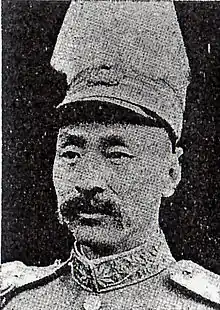Li Jinglin
Li Jinglin, also known as Li Fangchen[1] (1885–1931) was a deputy inspector-general and later army general for the Fengtian clique[2] during the Chinese warlord era. He hailed from Zaoqiang County, Hebei province, China. After his military career was over he settled in Nanjing, and in 1927 moved to Shanghai.[3] A renowned swordsman, he was known as "China's First Sword."
| Li Jinglin 李景林 | |
|---|---|
 | |
| Born | 1885 Zaoqiang County, Hebei, China |
| Died | 1931 (aged 45–46) |
| Other names | Li Fangchen "China's First Sword" "God of the Sword" |
| Nationality | Chinese |
| Style | Yang-style taijiquan Wudangquan Wudang Sword |
| Li Jinglin | |||||||||
|---|---|---|---|---|---|---|---|---|---|
| Chinese | 李景林 | ||||||||
| |||||||||
Military and administrative career
In 1924, during the Second Zhili–Fengtian War, Li was commanding the Fengtian Second Army[4] which aided Zhang Zongchang in his decisive victory at Longku; the engagement has been termed "probably the single most important engagement in Zhili's defeat."[5] In November his troops occupied Tianjin,[6] where they picked up half of Wang Chengbin's forces,[7] and under his command a "repressive and predatory" regime was established--especially noted is the extent to which the local merchants were extorted.[8] The US 15th Infantry Regiment, whose mission was to keep the Peking-Mukden Railway open, was based in Tianjin, and small skirmishes occurred between US troops and Li's forces.[9] Like many other warlords who ruled Tianjin, Li was a member of the Green Gang.[10] From December 1924 to December 1925 he was the administrator of Hebei province.[11]
Martial arts
One of Li's nicknames is "Magic Sword".[12] He displayed great skill as a swordfighter and great interest in martial arts, especially Wudang chuan. Li was nicknamed "China's First Sword" and "God of the Sword."[13] He was an expert in a variety of sword techniques, and later learned Wudang Sword from Sung Wei-I, a renowned swordsman who also taught Fu Chen Sung.[14] His sword techniques were an amalgamation of the ancient Taoist and the newer Baguazhang styles.[15]
After his military career he opened a martial arts center in Nanjing,[16] and became vice-president of the National Martial Arts Academy,[17] also known as Central Hall for National Martial Arts (Zhongyang Guoshuguan),[18] and now called the Central Guoshu Institute. On his initiative, a Yang-style t'ai chi ch'uan was formalized, with Yang Chengfu as the most important of the contributors.[19]
References
- Notes
- Chen 3.
- Waldrun 95.
- Chen 3.
- Waldron 95.
- Waldron 101-102.
- Chevrier 165.
- Waldron 214.
- Chevrier 166.
- Cornebise 38.
- Hershatter 128.
- Lin 30.
- Allen 50; Lin 27.
- Lin 31.
- Lin 27.
- Vercammen 126.
- Chen 3.
- Sun 31.
- Vercammen 125.
- Vercammen 125.
- Bibliography
- Allen, Frank; Tina Chunna Zhang (2007). The Whirling Circles of Ba Gua Zhang: The Art and Legends of the Eight Trigram Palm. Blue Snake Books. ISBN 978-1-58394-189-8. Retrieved 23 October 2010.
- Chevrier, Yves (2010). Citadins et Citoyens Dans la Chine Du XXe Siècle: Essai D'histoire Sociale. En L'honneur de Marie-Claire Bergère. Editions MSH. ISBN 978-2-7351-1177-0.
- Cornebise, Alfred E. (2004). The United States 15th Infantry Regiment in China, 1912-1938. McFarland. ISBN 978-0-7864-1988-3.
- Hershatter, Gail (1993). The Workers of Tianjin, 1900-1949. Stanford UP. ISBN 978-0-8047-2216-2.
- Lin, Chao Zhen; Wei Ran Lin; Rick L. Wing (2010). Fu Zhen Song's Dragon Bagua Zhang. Blue Snake Books. ISBN 978-1-58394-238-3. Retrieved 22 October 2010.
- Sun, Lutang; Tim Cartmell (2003). A Study of Taijiquan. North Atlantic Books. ISBN 978-1-55643-462-4. Retrieved 22 October 2010.
- Vercammen, Dan (2009). "Modernity Contra Tradition? Taijiquan's Struggle for Survival: A Chinese Case Study". In Rik Pinxten, Lisa Dikomitis (ed.). When God comes to town: religious traditions in urban contexts. Berghahn Books. pp. 114–44. ISBN 978-1-84545-554-5. Retrieved 23 October 2010.
- Waldrun, Arthur (2003). From War to Nationalism: China's Turning Point, 1924-1925. Cambridge UP. ISBN 978-0-521-52332-5.
- Chen, Weiming; Barbara Davis (2000). Taiji Sword. North Atlantic Books. ISBN 978-1-55643-333-7. Retrieved 22 October 2010.